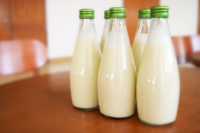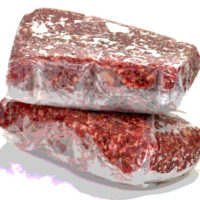Sponsored Content
Why Real-Time Temperature Monitoring and Track-and-Trace Technology Provide Supply Chain Control

As we enter the U.S. Food and Drug Administration’s new era of smarter food safety, it is critical that we consider the interoperability of the various technologies that we implement within the supply chain. No longer is it acceptable to adopt a tool for a specialized task. It is critical that technology helps us solve a variety of logistics, quality, food safety, and cold chain problems by utilizing the data in different ways.
The food supply chain is changing. An increasing need for transparency and traceability is driving new technology to the forefront. Terms that were once considered buzzwords, such as real-time visibility, the cloud, the Internet of Things (IoT), predictive analytics, and blockchain are increasingly becoming commonplace.
Having complementary pieces of information in various systems makes the utilization of the information difficult. Siloed data prevents businesses from gaining a complete picture of their supply chain. It can reduce the benefits that each tool offers due to an inability to view critical data through a single system. Stakeholders must understand how these technologies can work together to help them fully reap their benefits.
Food track-and-trace-technology, including blockchain, which utilizes distributed ledger technology and adds another level of transparency and trust by making data immutable, are already playing a role in the way that food brands are utilizing data for traceability and other quality, food safety, logistics, and business processes. These technologies are allowing organizations the ability to reduce the time it takes to identify the location of products for recall purposes from weeks to a matter of seconds.
As your organization is already likely considering the ways in which it can improve your supply chain by transforming it from a necessary, yet overlooked, process to a preventive control, these track-and-trace technologies have the ability to transform the way that we view traceability, just as real-time temperature monitoring has changed how we can now manage the transportation of perishable foods.
You may be asking yourself, ‘’How does IoT sensor technology work with blockchain and cloud-enabled track-and-trace solutions for transparency and traceability?’’ Simply put, each technology on their own can deliver value to stakeholders. When connected, the rich insights and transparency provided are more valuable than the sum of their parts.
It is often said that traceability data can tell you where a product started and where it has traveled through the supply chain once it is scanned at each touchpoint, but that these data cannot tell you whether the product is safe. When you are able to layer rich information such as time, temperature, location, and other sensing data on top of the traceability information, you have the ability to know with confidence that your products are safe for consumption.
This layering of data takes the best parts of traceability data, such as lot codes, dates, and any other piece of critical information, and attaches real-time temperature-monitoring data, which then becomes an unchangeable dataset that permanently lives with each product that is being traced. The process happens seamlessly through a relatively simple integration and, once complete, requires no manual work.
Today’s sensor and cloud technology allows each participant of the supply chain, including producers, logistics partners, warehouses, and distribution centers, to access product quality data captured in real-time through IoT devices. Data are automatically sent to a cloud software platform, where data regarding a single shipment or the entire supply chain can be viewed on-demand. These data complement traditional track-and-trace information by providing more granular information regarding product quality during shipment. Data analytics are captured in dashboards, providing actionable insights into supply chain operations and processes.
As an example: A shipment of fresh berries contains 5,000 cases, each with six inner packs, or a total of 30,000 distinct units. Each of those distinct units has the ability to contain the environmental conditions collected through distribution and warehousing as a permanent and unchangeable record. Consider the value that having this type of information at your fingertips and how it would change the way that you manage your customer complaints.
Sensing technologies have the ability to revolutionize the way that we manage traceability data, as the information is able to provide insights that standard information such as lot code, best-buy dates, and quantities cannot. Through the use of track-and-trace technology, we can create concise packets of rich and highly usable information that can be accessed immediately and provides organizations with the ability to work from a place of prevention instead of reaction.
As the industry has come to realize, the standard expectation for traceability of one-up, one-back severely limits the ability of organizations to effectively manage recalls. Consider this: If your organization was able to know that an incident within your distribution system occurred, and that actions were taken to mitigate a significant food safety risk before a substantial temperature deviation occurred, how would this enhance your traceability efforts? Considering the reputational risks and unintended consequences related to a food safety recall, how much better equipped would you be if you could move from reaction to prevention?
As you consider the requirements outlined within The Food Safety Modernization Act’s Sanitary Transportation rule and you think about the implementation of real-time solutions for monitoring supply chain temperatures and tracking-and-tracing products in the event of a recall, you are bound to discover that utilizing these technologies together enhances your ability to proactively monitor your supply chain and respond to risks when needed, while providing data that are auditable and facilitate a defensible food safety program.
Implementing a full supply chain visibility solution should include the adoption of systems that can easily integrate with one another to provide a centralized source of truth for your supply chain. As a final point, remember that it is important to design what you want to accomplish through an integrated platform at the beginning of the project to ensure that you meet that goal when the final product is handed over, as this will save you from obstacles in the end.
Too often, we focus solely on product traceability when we discuss track-and-trace technology, but it is important to remember the additional organizational benefits that are available through the utilization of the different transparency solutions that are available. Various departments within a business community can utilize the supply chain data to improve business practices, such as improved logistics through shipping patterns that drive fuel and time savings, improved vendor management through score carding, and improved transportation security through the identification of light events during distribution to name a few. Simply put, the ways to use the data are endless.
How will your organization embrace it?
Jeremy Schneider is the business development director, Food Safety and Quality Assurance, at Controlant. He has more than 15 years of experience in the food quality, safety, and regulatory sector. His experience spans managing food safety and quality systems within several fast-casual restaurant chains as well as food manufacturing, including Chipotle, Boston Markets, and Rocky Mountain Foods. During his career, he has addressed some of the most challenging and critical risks faced today by major consumer food brands. He can be reached at jeremy@controlant.com.
Looking for a reprint of this article?
From high-res PDFs to custom plaques, order your copy today!




